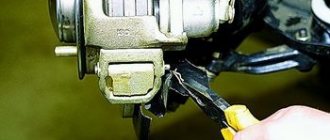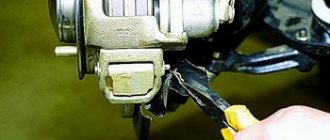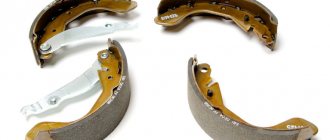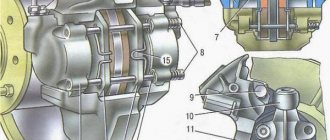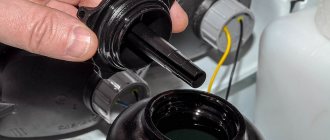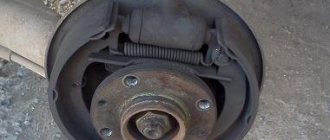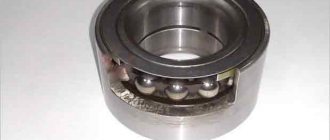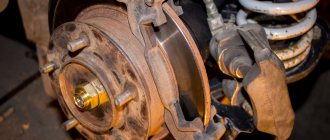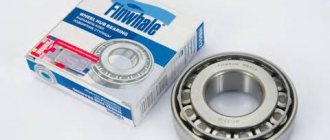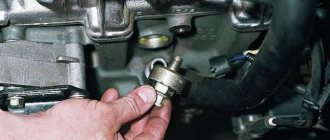Replacing rear brake pads
The Chevrolet Niva car is highly reliable and durable.
One of the important advantages of this car is the ability to make minor repairs yourself, without visiting a service station. One of these components is the car’s braking system. The ability to change consumable parts and independently perform diagnostics increases the safety of the driver and passengers and makes the trip safer.
The Chevrolet Niva has drum-type brakes on the rear axle. The main component that needs to be replaced periodically are the brake pads. The car manufacturer recommends checking the pads after 20,000 miles. Replacement is carried out after 30,000 kilometers.
But do not forget that, first of all, these parameters depend on the driving style and operating conditions of the car. On roads with poor surfaces, you tend to have to slow down more often, which leads to faster pad wear. Mainly the outer lining suffers, as it wears out much faster. To monitor its condition, there is a special window on the drum through which you can see the level of wear.
The car can be used if the thickness of the lining is more than 2 millimeters. Otherwise, it is necessary to replace all linings on the rear axle. All 4 are replaced, and in this case the level of wear of the others does not matter.
If you partially replace the brake linings, this will lead to a deterioration in the driving performance of the car and problems with the operation of the braking system. When braking, the car will move away from the trajectory.
To replace brake pads in a field, you must place the car on a flat surface. After this, you need to put stops under the front wheels to prevent them from rolling. The vehicle must be released from the parking brake.
Next, you need to slightly loosen the wheel bolts, lift the car with a jack and remove the wheel.
For further actions, you will need a key size 13. Use it to loosen the parking brake cable. To do this, loosen the nut and locknut.
After this, using a 12mm wrench, unscrew the bolts holding the brake drum.
If the car was driven in winter, a problem such as drum sticking may occur. To fix this problem, you need to tap the drum around the circumference using a wooden or rubber mallet. If you don't have a mallet, you can use a regular hammer. But the blows must be delivered through a wooden block or piece of rubber.
Attention! The use of lubricants is strictly prohibited. This can damage the vehicle's braking system.
After the drum is removed, it is carefully inspected for damage. Sometimes, when using a car, cracks, grooves or chips may appear on it. If there are defects, the drum must be replaced.
Before removing the Chevrolet Niva brake pads, you need to use two levers to press the pistons into the wheel cylinder. This is necessary to install new brake pads.
The garter spring and spacer bar are removed next. Be careful when removing, as a spring that pops out can hurt your hands.
Then, using pliers, you need to unscrew the outer cup until the slots on it line up with certain protrusions on the stand.
These parts are quite small; it is better to use a separate container for storing them. If there is rust or dust on the surface, it must be cleaned immediately.
Now you can carefully move the front pad to remove the lower spring.
In a similar way, the rear block is removed and the cable that controls the parking brake is disconnected.
Replacing rear brake pads on a Niva Chevrolet usually does not take much time. Installation of new pads and assembly is carried out in reverse order.
After completing the work, you must press the brake pedal firmly several times so that the system sets the necessary clearances and adjusts the position of the brake pads. Also, after replacement, it is recommended to maintain the speed limit and avoid increased braking efforts.
Source: expertniva.ru
Changing brake pads Niva Chevrolet
Chevrolet Niva owners usually operate their iron horse both in rural areas and completely off-road. And they are often forced to change many parts themselves, using a minimal set of tools and ingenuity. Therefore, for most of them it will not be difficult to replace the brake pads themselves. Moreover, they are essentially consumables and, depending on the conditions of use, cover from 5 to 15 thousand kilometers.
A complete set of front and rear pads will cost from 2,500 thousand, depending on the manufacturer. It should be taken into account that if the replacement is incomplete on one axle, the car may pull to the side when braking. Therefore, it is best to change the pads completely, or separately front or rear.
Serial Niva with diesel engine
From the very beginning, engineers at the plant tried to implement the idea of installing a diesel engine on the Niva 2121 model. For the Niva it was planned to use a domestic version of the 1.5-liter turbodiesel engine. With such a unit, prototypes were unable to effectively cope with off-road driving due to insufficient power.
Having abandoned the idea of installing their own diesel engine on the Niva, the engineers proposed the option of installing a Peugeot brand diesel engine. The French diesel engine received the factory index Peugeot xud9sd, has several versions with different boosts (69-75 hp) and is widely represented on different car models.
Engine design: diesel, in-line, 4-cylinder, longitudinally mounted. Working volume: 1905 cm3. One of the modifications of this diesel engine, when installed on the Niva, provided the vehicle with the following dynamic performance and performance characteristics:
| Maximum power: | 48 kW (69 hp) at 4600 rpm |
| Torque: | 121 Nm/2200 rpm |
| Maximum speed: | 120 km/h |
| Acceleration 0-100 km/h: | 25 sec |
| Average fuel consumption per 100 km: | 8.0-8.7 l |
The Niva with such a diesel engine turned out to be economical and performed well off-road, since the Peugeot xud9sd diesel engine provided the all-wheel drive vehicle with decent low-end torque. An additional advantage of the imported diesel engine on Niva was its reliability and relative ease of repair and maintenance.
As for the dynamics, the Niva 2121 with the Peugeot xud9sd engine accelerated to “hundreds” very slowly. The emphasis was placed on the main purpose of the car - increased cross-country ability on all-out off-road conditions. The Niva model with a Peugeot diesel engine was included in the series, but the car was produced in limited quantities and was also exclusively exported. In 2009, serial factory production of the diesel Niva completely ceased.
How to change rear brake pads on a Chevrolet Niva
Chevrolet Niva is a car from the SUV class. And for an SUV, the condition of most control systems is the key to successfully passing an obstacle. Thus, an important role is played by the braking system and the parking brake, which performs the function of blocking the wheels while stationary. Blocking or braking of the rear wheels of the car is performed by drum brakes. The most important elements of these brakes are the rear pads of the Niva Chevrolet. Actually, this article will tell about them.
Removing a soured brake drum VAZ 2123 / Russian crazy service car
In this video I show how to remove a drum that has become soured on the axle shaft. Special pullers couldn't cope with this.
Having learned from the “bitter” experience of the previous 10, having driven the tires from the passenger compartment, the very first thing I did was remove the drums. I coated the seats with graphite. Such questions no longer arise! ! ! and also loosened all the nuts on the brake pipes, including the ABS unit, one by one. made it possible to lubricate the brake nut contact.
Read news about the new Niva
- How to bleed the brakes of a Niva Chevrolet
- Hard or soft brake pedal. What is the reason and what to do
- Rear disc brakes
- How to bleed brakes on a Chevrolet Niva correctly
- Brake system Chevrolet Niva
- How to tighten or replace the handbrake on a Chevrolet Niva
- Creaking pads: How to fix whistling when braking
- Chevrolet Niva bolt pattern: diameter of the holes in the Chevy Niva, what is the bolt pattern of wheels and rims in the Chevrolet Niva, radius 15 and 16
What are pads
The brake pads are arched in the shape of the letter “C” and are installed in the rear wheel drums, where they do their work. The brake pad consists of the following elements:
- main part made of special steel;
- friction lining applied to the brake pads from the back of the head;
- fastening elements, which are various holes.
Rear brake pads
Let's briefly consider the principle of operation of the rear pads. So, the brake pads are located in the rear wheel drums, two in each. They are located with the inner side facing each other, and the outer one, with a friction layer, interacts with the wheel drum. The resulting interacting force, which is accompanied by the release of energy, ultimately leads to the car stopping.
When you press the Niva Chevrolet brake pedal, pressure is created in the brake system, which acts on the pistons of the working cylinders of the front and rear wheels. Next, the so-called extrusion of the pads occurs; the friction part interacts with the moving wheel drum (or disk) and leads to its braking. As the pads wear out, the friction layer wears off. The inside of the drum is also erased.
When is pad replacement necessary?
Before replacing the rear pads, an inspection must be carried out. A malfunctioning handbrake does not mean that the brake pads are urgently needed. They change in the following cases:
- If the thickness of the friction layer is less than the permissible value, that is, less than 1.5 mm.
- There is oil or other liquids on the lining.
- There are cracks, gouges or chips on the layer.
- Poor connection between the gasket and the base.
Only disassembly and detection of one of the above damages indicates the need to replace the pads.
What's really in AVTOVAZ's plans? Niva Next?
It can be assumed that AVTOVAZ will bet on three models at once: a “large” crossover based on the Renault Duster (especially since the plant has suitable engines in the line of produced models) and... the next generation Niva 4×4 2015. However, with the latter It seems that this will happen no earlier than 2021, and before that new units and components under the VAZ 21217 symbol will appear in the old body.
Recently, a survey was conducted on the website avtovaz.ru, where they assessed the possibility of mastering a single-wheel drive version of the car. Considering that it would be more logical to make a rear-wheel drive version of the standard Niva, the possibility of a car with front-wheel drive can only be regarded as an application to replace the traditional manual transmission with a friction clutch. There was no limit to the anger and intensity of passions. “Nivovody”, known for their grouping, immediately reacted by unanimously voting against. This is quite understandable: there are a lot of SUVs on the market now, but the niche of specialized cross-country vehicles, but with a certain comfort, is not particularly filled.
Perhaps it's worth looking for a compromise? But for consumers, it is already planned to replace the center differential locking lever with... electric control. Push-button. The replacement of the old engine with a unit from the Lada Priora (with subsequent depowering to 90 hp) is not far off. A rear-wheel drive version of the extended (2131) car is also being prepared. It is worth recalling that earlier they wanted to stop the production of the classic Niva 4x4 for the sake of Shniva, but then they defended it.
Now there is no question of protection. Vice versa! With the arrival of Boo Anderson, the Niva 4x4 2015 project received a previously unseen favored treatment (and, of course, funding).
The new generation of Chevrolet Niva will not be an “internal” competitor, since it is being created on one of the GM platforms, and the existence of the GM-AVTOVAZ joint venture is vague, and the Duster will be in its current class by 2021 (that’s when the new Lada Niva 4 is planned to appear ×4) will already sink into oblivion...
In addition, the control of the Renault-Nissan alliance over AVTOVAZ is not complete. The deal has not yet taken place. And will it happen now?
Replacement of rear brake pads of Chevrolet Niva
Tools:
- Pliers
- Medium flat screwdriver
- Small hammer
- Wheel chock
- Rolling jack
- Rubber bulb
- Brake fluid container
- Wire brush
- Mounting blade (2 pcs.)
Parts and consumables:
- Rear brake pads
- Graphite grease
- Aerosol lubricant type WD-40
- Brake fluid
Note:
The minimum permissible thickness of the friction linings of brake pads is 1.5 mm. Replace the pads in the following cases:
– the thickness of the linings is less than 1.5 mm;
– the surface of the linings is oily;
– the linings are not firmly connected to the base;
– the linings have deep grooves and chips.
Warnings:
Do not use gasoline, diesel fuel or any other mineral solvents to clean brakes. Replace the brake pads on both rear wheels at the same time. It is not permissible to replace the front and rear pads with each other, as well as between the left and right wheels. This may result in uneven braking.
You will need: pliers or a screwdriver, two mounting blades.
1. Engage 1st gear and install thrust blocks under the front wheels.
2. Check: the parking brake lever must be lowered all the way down (the car is released).
3. Remove the wheel.
4. If the brake fluid level in the master cylinder reservoir is at or close to zero, pump out some of the fluid from the reservoir. Otherwise, when replacing the pads, it may splash out.
5. Remove the brake drum as described here.
6. Remove the lower tension spring using pliers.
7. Rotate the upper pressure spring cup 90°.
8. Remove it along with the spring and lower cup. Remove the pressure spring rod from the brake shield.

